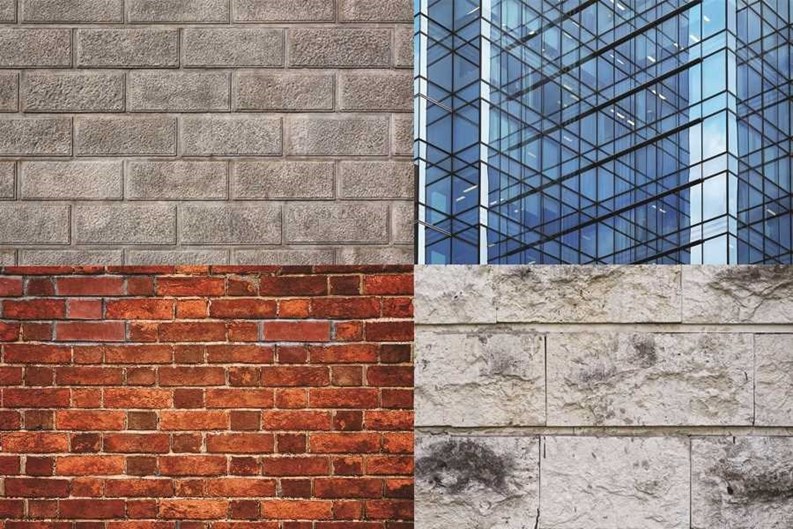The old expression says, ‘put your best face forward,’ and the same goes for co-op and condo buildings. But a building façade is more than just the face it shows to the street—it’s a protective barrier against the elements and an integral part of the building’s structure.
Face/Off
In New York City, building facades are often made of a different material (often brick or limestone) than the rest of the building. Tough as these materials are, they're not impervious to potential problems down the road. Over time, brick and other facades can still deteriorate, so they need upkeep.
“The most common types of facades are load-bearing, cavity-wall and curtain wall facades,” explains Joakim Aspegren, AIA, of Architecture Restoration Conservation, PC in New York City. “Load-bearing walls are typically found in prewar buildings, while cavity-wall facades emerged in the late 1950s; curtain wall facades in residential buildings are a more recent phenomenon, although some examples started to appear in residential construction in the late 1970s and mid-1980s.”
“Facade materials can also depend on building height,” says Russ Fernandes, principal/senior vice president of Becht Engineering BT, Inc., which has offices in New York, New Jersey, and nationwide. “Probably the most common façade type for new construction in New York City is brick veneer. Such buildings have a brick exterior 'skin' with an air space or cavity and a backing wall of either masonry (concrete) block or on a gypsum board type sheathing on steel studs.”
“A cavity wall construction consists of three layers,” explains Mena Barsoum, a project manager with Kipcon, a national engineering and consulting firm with offices in New York and New Jersey. “Beginning with the outermost layer of a building, the first layer is the exterior wall.”
This layer can be brick masonry, terra cotta, pre-cast stone, limestone, metal panels and decorative metal cornices, or a combination of any of those. Barsoum explains that brick masonry is the most common. “The exterior wall is tied back to the building's structural wall with brick ties that occur usually over 3 to 4 courses of brick and are typically installed 16 to 18 inches on center.”
The next layer is the air space (cavity). “Brick masonry is a porous material that allows water to migrate through,” Barsoum continues. “This space serves as an outlet for the water retained by the masonry to drain out through the weep holes or to dry through the air vents that are in the exterior masonry.”
The third layer is the load bearing/structural (interior) wall. This wall may be constructed from brick masonry (in double wythe wall construction), or CMU (concrete masonry unit) blocks. “This is the wall that would be facing in towards the habitable space,” says Barsoum.
“Depending on the kind of construction and application this wall would be typically waterproofed with self-adhering waterproofing membrane which would protect against the water that travels through the external masonry wall.”
While facades are typically anchored to the building’s structural frame, according to Aspegren, in early, low-rise masonry construction, load-bearing brick facades were attached to floor joists at every floor level through the use of iron tie rods. “The rods would extend through the façade and terminate in the form of large ornamental iron plates, often shaped in the form of a star,” he says.
“With the development of steel frame construction in the early 20th century, facades typically consisted of two wythes (or layers) of brick with the inner wythe supported by the building’s frame and the outer wythe supported by header bricks, typically every five to six courses. With the advent of the cavity-wall in the second half of the 20th century, the outer wythe of masonry was separated from the inner wythe by an air space which would form an air cavity. The outer wythe would be supported by shelf-angles bolted to the building’s structural frame.
Fernandes also explains that taller buildings in particular might utilize a panelized or curtain wall exterior. “In both of these examples, the façade does not perform a structural function, aside from supporting its own weight,” he says. “Older buildings however, depending on their age, might be of solid wythe masonry (essentially solid brick) where the brick exterior also serves a structural purpose. With solid wall construction, the visible brick is also part of the structure that supports the building.”
To Aspegren, the most interesting facades are those that adapt to the exterior environment, while allowing for comfortable, adaptable interior spaces as well. “I am referring to the use of movable elements in the building envelope that control the amount of light or heat transmitted to interior spaces,” he says. “The glass double façade is also a great example of a new façade type that can regulate or control the interior climate of buildings. From a historical perspective, I'm fond of cast-iron facades which, besides their beauty, also represent an early example of large scale pre-manufactured building facades.”
The Toll of Time
Over time, even the most solid, well-constructed facade will show signs of wear-and-tear at the hands of the elements; rain, snow and ice (especially ice), pollution, corrosion of metal elements, and wind erosion. This deterioration can eventually lead to problems like falling debris and water leaks.
“The façade material helps minimize the amount of water that gets through to the underlayment, but the building should be essentially leak-proof with just the underlayment and flashings installed,” says Fernandes. “A brick veneer façade allows water to pass through, especially during prolonged, heavy rains and during windblown rain conditions. However, with a properly constructed wall, the water should be directed back out of the wall at the base of the cavity section.”
The concept of waterproofing facades is relatively new. “Early facades relied on the large thickness of walls to provide a natural waterproofing and insulation through shear mass wall resistance and no waterproofing was used,” says Aspegren. “With the advent of the cavity wall, some efforts were made to control the flow of water away from interior walls. This was achieved through the use of the cavity wall itself, which provided a natural separation to the inner wall, and also through the use of waterproofing membranes at shelf-angles. Unfortunately,” he says, “the waterproofing membranes of that era become brittle after approximately 30 years in service and cease to work as originally intended, and water can still bridge the cavity wall through masonry anchors.”
In addition to water prevention, cleaning the building’s exterior is extremely important, especially on curtain wall buildings. “Masonry facades typically have to be cleaned just once every 50 to 70 years,” says Aspegren. “This is in sharp contrast with curtain walls, which need to be washed at least once per year. Maintenance for masonry facades typically consists of repointing mortar joints, and replacing damaged bricks or cracked window sills. The primary maintenance issue with curtain wall facades involves the replacement of window sealants and gaskets which typically will only last for 20 or 30 years.”
“Building superintendents are the eyes and ears of the board and managers,” says Fernandes. “They in turn should keep their eyes open to any changes, such as cracks, that they might see. They also should facilitate getting the proper professionals involved at the earliest signs of trouble (such as reports of water leaks). Water leaks in units, even if seemingly minor, should never be considered acceptable, and should be corrected in a timely manner to prevent more costly repairs down the road. In the case of buildings, problems never get better on their own.”
Local Law 11
Local Law 11, now known as the Façade Inspection and Safety Program, or FISP, has had a tremendous effect on the proactive maintenance of buildings in New York. According to the Department of Buildings (DOB) website, owners of buildings greater than six stories must have their buildings’ exterior walls and appurtenances inspected once every 5 years and file a technical report to the Department of Buildings.
“Local Law 11 has aided buildings in ensuring a constant upkeep of the building’s exterior condition is maintained,” says Barsoum.
“By inspecting the building, the engineer/architect is able to determine areas that require immediate or future repairs, or if the building is classified as safe and does not warrant repairs at the present time. It also gives the engineer/architect the opportunity to observe any apparent signs of structural deficiencies of most exterior components such as fire escapes, parapet walls, and window lintels.
Facade inspections are to be conducted by a Qualified Exterior Wall Inspector (QEWI). The QEWI can be either a New York State professional engineer or registered architect with at least one year of relevant experience. A building is required to be inspected once every five-year cycle. “Repairs that have been recommended in the previous cycle’s report should be addressed before the commencement of the current cycle’s inspection,” says Barsoum. The next round of facade inspections start February 21, 2015 and extend through February 21, 2019.
So whether your building is a prewar gem with lots of decorative exterior elements, or a sleek new glass-and-steel construction, knowing what your facade is constructed of and how to maximize its life span through inspection and proper maintenance can save your building money and legal issues in the long run.
Lisa Iannucci is a freelance writer and a frequent contributor to The Cooperator.







Leave a Comment